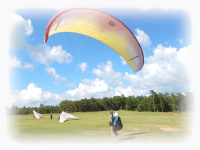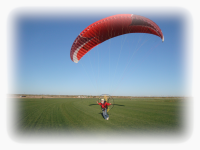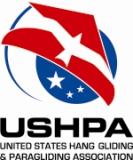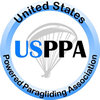Radio information and setup for ultralight pilots
By Had Robinson
updated September 21, 2024
A. Radio information
Why bother having a 2-way radio, getting the proper license, and learning how to use it? "Hey, I have a walkie-talkie!" You're on your way but it is not so easy, especially when your life can depend on it.
Pilots have been killed because of one of the radios in use by a group of pilots in the air was stuck in transmit mode. This effectively makes the common frequency unusable by everyone else (and is why all non-ultralight aircraft must use a different radio mode of operation) . Properly setting up the FM 2-meter radio we ultralight pilots use can help prevent this kind of tragedy. For example, knowing how to setup the "transmission timeout timer" in the setup section of the radio is CRITICALLY important. Setting it to 60 seconds or less will automatically turn off a continuously transmitting radio so others can use the frequency during ordinary operations or if there is an emergency.
1. The Sena for HG & PPG/PG - a safe alternative to the 2-way radio
I have the 30K Sena system and use it for PPG, especially when I fly solo because I can easily receive and make cell phone calls via the Sena Bluetooth feature. However, this system costs about 3X or more than the price of a quality FM 2 meter transceiver. I do not recommend it for HG or PG because of its cost, range, and lack of simplicity. The Sena system is primarily designed for motorcycle riders who like to group chat. It can also be buggy. There are times when I have to power cycle the Sena to get it to work correctly. An advantage of the Sena (not connected to a FM transceiver) is that it is 100% legal per the FCC.
Using the Sena with a 2 meter radio is a bit complex and requires the SR10 two-way radio adapter. The default setup is for VOX (voice operated transmission) but PTT can be used via a setup option. The noise canceling microphone of the Sena is the best on the market and better than the NAC system used on the ICARO PPG helmets. A typical 2 meter Sena setup has poorer audio quality compared to a 2 meter radio connected to a speaker/microphone.
When flying PPG, I have both my cell phone and 2 meter radio connected to the Sena system. In general, I only use the Sena group chat system if it is what others have or I need easy access to my cell phone while flying.
If a cell phone and a 2 meter radio are both connected to the Sena, pilots may experience an annoying bug if the cell phone and external radio are used at the same time e.g., while you are using the radio and a phone call comes in. One or the other can get extremely loud and some of the time the cell phone incoming voice can get badly distorted. I have complained to Sena about it but they have not done anything yet. In sum, if you use the Sena with the SR10 disconnect the cell phone or turn off the SR10.
The Sena can also play your favorite music or podcast but flying an ultralight is an intense operation and distractions only increase risk. Another downside and serious nuisance of the Sena is that if your cell phone has a music player it can kick in at any time if you hit a button on the Sena the wrong number of times. A simple work around is to force stop the music player on your cell phone before launching. Note: newer firmware version and updates of the programming software may have fixed this.
In general, I would not spend the money on the Sena unless your PPG flying group uses it.
2. Get your Amateur Radio operator license
All pilots would benefit from formal training on how to use a 2-way radio (and, possibly, save their own lives) if they would get their FCC amateur radio license. It is so easy and local hams are happy to help. Using a radio is way more than just "hitting a button". How do you know you have been heard by other pilots? Why is saying "affirmative" and "negative" rather than "yes" and "no" critical for pilot safety? Why have a power setting on the radio and why does it matter? What is the proper way to speak into a microphone? How long should transmissions be? What is the danger of a "chatty" operator? Radio skills are no different than flying skills. That is, they both require effort and focus. But, like being injured in some backward foreign country, "That will never happen to me so I don't need to know..." is a common but mistaken attitude than often enough leads to disaster.
I routinely deal with new pilots who are smart, well educated, and competent in their fields (including military aviators) who have had serious accidents, some permanently crippling, because they *thought* they knew how to fly an ultralight. One of my students wishes he had listened to me as he will never fly again nor walk particularly well. Pride, ego, and especially ignorance are not compatible with long term aviation safely.
The American Radio Relay League has this helpful resource for those who want to become licensed. You will want to study the section on the Technician Class license. To find a training class near you, complete this form.
Use of the Amateur bands by pilots who are not licensed will upset Amateur Radio operators who hear them and can result in complaints being filed with the FCC. Getting noticed by the FCC is similar to being noticed by the FAA. The pilot may need lots of money (fines) to make either go away. Don't be a nuisance. We already have way too many of these people in our flying community who have helped ruin the public's attitude towards our sport in some parts of the U. S., especially on the West coast and in New England.
Rude and/or dangerous pilots affect us all and these people are *not* our friends. Site loss due to these people is a serious problem!
3. USHPA radio authorization for special frequencies
Study the USHPA Radio Authorization (RA) guide, take the easy exam (administered by any USHPA instructor), and apply to USHPA for an RA license. It is just $15 USD. The guide was authorized by the FCC (Federal Communications Commission). Studying will help pilots obey the law and, more importantly, increase their margin of safety while flying.
Here are the special USHPA radio frequencies which are located in the commercial 2 meter business band: 151.505, 151.625, 151.925, 151.955, and 158.400 MHz, simplex, no tones USHPA call sign: WPRY420
B. Radios for pilots
Note: all transceivers MUST be correctly programmed in order to function safely in a aviation environment. A pilot's life could depend on it!
1. YAESU FT-60R – one of the best 2 meter radios for HG and PG/PPG pilots
Advantages
- Shows the battery voltage when it powers on. No other radio has this feature. Knowing if your battery is about to go dead could be helpful before launching. It could save your life e.g., if you must land in a tree or in the water.
- Exeptional receiver sensitivity and selectivity, extremely durable.
- Has a simple connection to the external speaker/microphone. It can be easily connected to the ICARO PPG helmet for PPG.
Disadvantages of the 60R
- An important disadvantage of the 60R is that the external speaker/microphone connector MUST be held in place with a rubber band, a piece of Velcro, or by a tightly fitting radio pocket/harness. If it pops out partially, the radio will go into transmit mode until the battery goes dead if the TOT timer is not set. Note: pilots have been killed because their radio went into transmit so no one could hear anyone else during a cascading emergency.
- It must be modified internally to transmit on the USHPA authorized radio frequences. This mod requires advanced electronic skills. Southwest Airsports offers the 60R with the modification for those who do not wish to do the necessary modifications.
The YAESU SSM-17A external speaker/micophone for the 60R with windscreen (available on eBay) is an important accessory for use in the air.
2. YAESU FT-65R – a close second to the the FT-60R
Note: the 65R is NOT a substitute for the 60R.
Advantages of the 65R
- Easily programmed to transmit on the USHPA authorized frequencies
- Smaller than the 60R
- More secure external speaker/microphone connection that is less likely to pop out.
- Costs much less (to be more competitive with the Baofeng)
Disadvantages
- Does not display the battery voltage when turned on
- Cannot receive Airband AM signals (the band that all other non-ultralights use)
- Receiver sensitivity and selectivity is not as good (this is where the $$$ are in all radios)
In sum, the features of the 60R, in my opinion, are worth the extra $55 or so. The cost is more if you are not able to do the circuit board modification yourself.
The YAESU SSM-17B external speaker/micophone for the 65R with windscreen (available on eBay) is an important accessory for use in the air.
Other brands and YAESU models may be more complicated to operate when flying, may constantly drain their batteries when off, have a complex external audio connection (a screw in connector), are difficult to program and switch batteries, lock the keypad, etc.
3. Baofeng
Advantages
- Costs about 80% less than any other radio
- Simple and easy to operate
- Transmits on the USHPA authorized frequencies out-of-the-box
- Compact and lightweight
Disadvantages
- Severely limited in receiver sensitivity and selectivity which is why it is so inexpensive. As a result, it has serious issues with interference from near-band transmissions from commercial operators. If you live in a remote area away from big cities like we do, the radio will suffer less from this problem.
- No easy way to check battery voltage.
- Antenna is a piece of junk. Pilots may purchase the superior Nagoya NA-701 SMA Female Dual Band Antenna for around $12 which will greatly improve reception. However, it will also mean that near-band interference, if any, will also be worse.
- Poorly constructed
- Has modes which may interfere with normal operation that can be easily and mistakenly activated and are a major nuisance if you are flying.
We own a bunch of these radios but they are never used where radio failure could be hazardous to the pilot i.e. we use them for ground to ground communication. It should NOT be used for pilot to pilot communication in the air.
4. Commercial business band radios
Why not purchase a business band radio with the requisite FCC license? Pilots may have to spend upwards of $500-$1,000, construct special adapters in order to use it with the common helmets, and be burdened by a much larger and heavier radio that requires expensive batteries and a special charger. The FCC knows that the YAESU and other 2 meter radios can be modified to work in the business bands and that some, like the Baofeng, work out-of-the-box. However, they choose to do nothing about it. I can only surmise that this is because the HG, PG, and PPG community is so small that this technical violation of the rules is not an issue for the FCC and the violation may continue to be ignored – for now.
PPG'ers should get their amateur radio license because the USPPA has no station license in the business bands that their members can use.
5. Aviation band radios
Aviation band (air-band) radios which are required and used by the entire world of non-ultralight aircraft are very different than the typical 2 meter radios that are used by hams and business band users. The air-band radios are used for communication between all general aviation aircraft and between aircraft and air traffic control towers. They have special frequencies and utilize a special form of modulation (AM). There is nothing anyone can do to modify, rig, purchase, etc. that will enable a 2 meter FM transceiver to transmit in AM mode. (If you know of way to modify them or rig it, please let me know and we will share with the world.) The transmitting section of an AM radio is radically different than that of an FM radio. Pilots can read here why aviation uses AM rather than FM. It is a important safety issue due to the FM "capture effect".
If you plan on operating near an airport or going cross country (HG, PG, or PPG), an air-band radio could prevent an accident. Always announce your intentions to other aircraft in the area e.g., "Poteau traffic, this is PPG07, will be launching from the ultralight operating area at 0900 hours and heading south, Poteau traffic." An airport manager or a general aviation pilot can help with the best content of an announcement, the correct frequency to use, etc. HG, PG, or PPG pilots that operate near busy aviation traffic need to demonstrate that they are responsible, something that too many are not. Their irresponsible behavior affects the rest of us and is the main reason that so many airport managers and general aviation pilots are hostile to ultralight operations anywhere near them. Will you do your part? I hope so.
Because paramotors do not have shielded ignition systems, reception of signals from air-band radios may be unintelligible. PPG pilot Frank Hoffman has done some experimenting with this and has discovered that the use of a resistor type spark plug greatly helps reduce ignition noise. This type of plug has an "R" in the model number. NGK plugs are all available with or without a resistor.
Pilots can purchase a handheld air-band radio like the VERTEX FTA 450L for about $250 as of 2020. However, PPG pilots must also purchase the cables and pigtails required to connect to a typical ICARO PPG helmet.
6. Antenna for use on the USHPA frequencies
Radios operating on the USHPA frequencies will have greatly improved reception and transmission if they have antennas that are tuned to those frequencies (the Business 2 meter band).
For radios with the male SMA antenna (most radios): COMET-NCG HT-55
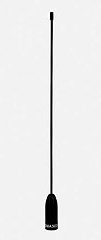
For radios that have the female SMA antenna (FT-60R, Baofeng) purchase this SMA barrel connector in order to use with the above antenna.
C. Radio setup
Warning
A problem of the YAESU FT-60R (and some others) is the connection to an external speaker/microphone. Pilots must either have a radio harness that will FIRMLY hold the connector in the radio, a rubber band, or a piece of Velcro to put around the radio to hold the connector in place. IF THE CONNECTOR SLIPS OUT PARTIALLY THE RADIO WILL GO INTO TRANSMIT MODE!
1. Radio manuals
- BAOFENG quick setup
- BAOFENG (reference)
- ICOM A5
- YAESU FT-60R – the best radio ever made for paragliding and hang gliding pilots
- YAESU FT-65R – not as good as the 60R and why it is cheaper than the FT-60R. Advanced manual for the 65R (mostly additional programming features)
- YAESU FT-70DR – drains the battery, even when off. This is a major and serious nuisance!
- YAESU FT-250R (discontinued)
- YAESU FT270R (discontinued)
- YAESU VX150 (discontinued)
- YAESU VX170 (discontinued)
- VERTEX VXA220 (discontinued air-band radio)
- YAESU FTA 450L (air-band radio)
The instructions below are for the YAESU. Other brands of 2m FM amateur radio transceivers are similar. Note: these are not instructions for setting up an aviation band radio.
2. Radio modification for the USHPA frequencies
Most 2 meter high quality handheld transceivers will not transmit on the USHPA authorized frequencies without modification. The exceptions are the Baofeng which works out-of-the-box and the YAESU FT-65R which must be re-programmed.
Other radios must be modified. We sell the modified FT-60R, if needed. A bonus in having us modify the radio is that, if requested, we will completely program the radio for the USHPA frequencies and enter the correct setup options. It makes the radio ready-to-go.
3. Microphone position & windscreen
PPG pilots have high ambient noise because of the propeller and, to a lesser extent, the engine. Some types of noise-canceling sets require the pilot to almost touch the microphone
with the mouth. Pilots will have to experiment with their particular headset to determine what is the best position of the microphone.
For HG and PG this not a problem if a
windscreen mitten (available on eBay) is put over a speaker-mic extension that plugs into the radio. The Sena systems used by
motorcycle riders have excellent noise-canceling microphones that attach to the helmet.
4. Set mode items of critical importance to pilots
If your radio is not working properly, completely reset it before making the following changes. On how to do this on the YAESU, see "Resetting the radio" below or refer to the respective manual for your radio. You may lose any pre-programmed memory values, however.
Some radios may be different in how to enter the SET mode but the SET parameters are similar for all radios, including the Baofeng. Please refer to the "Baofeng Quick Setup" link above to program the SET functions on that radio.
YAESU – Press the “F” key (function key) and then “0” (set key). Rotate the dial (can be the inner or outer dial) until the number you wish to check/change appears at the left of the display. Press the “F” again to toggle between the item description and the value. Change the value by rotating the top (or bottom) right knob. To save, be sure the display is the description, not the SET value and then press the PTT button to save and return to the mode you left (VFO or MR). For other radios, check the respective manual.
Recommended settings for most radios
9 Rx SAVE – OFF (receive save function) – default is .25 sec
10 Tx SAVE – OFF (transmit save function) – default is off
11 APO – 1 hour (automatic power off) – default is off
22 TOT – 1 minute (transmission time out) – default is off (This SET value is CRITICAL for the safety of other pilots!)
32 LK Mode – K + D (all keys & dial locked) – default is key only
56 Weather alert scan – (optional) the radio will scan the weather channels for the NWS alert tone e.g., "severe weather is approaching"
Transmit power level – mid level or 1 watt. Do not be a pest and use the 5 watt or greater level. You will also kill your battery quickly.
ARTS – Auto-Range Transponder System should be set to off (it is unnecessary for pilots).
Changing the various set commands from their defaults without thoroughly understanding what you are doing can easily make your radio a nuisance (and even dangerous) to yourself and others, especially #22 (TOT). Southwest Airsports will program your radio and NO CHARGE if sent to our address on the contact page as a service to USHPA and USPPA members. You only have to pick up the shipping cost, both ways.
Transmit/Receive Save Function (#9 & #10)
Both these set functions save battery power but have significant drawbacks. For example, waiting 2 seconds for your receiver to turn on after it receives a transmission will cause you to lose the first 2 seconds of what is being transmitted. Activating the transmit save function lowers the radio’s transmit level if the prior received signal is very strong. If you are near another pilot and receive a transmission, the next time you transmit, your power level will be lowered greatly. If the other pilot flies away, he won’t hear you as your power level may be too low. It will not correct itself until he contacts you again. Meanwhile, you have no idea whether your transmission was heard or not. It gets more complicated if you have many pilots. Turn these features off!
APO automatic power off (#11)
There is nothing more annoying than to be at launch, turn your radio on, and nothing happens. A serious design flaw with YAESU radios is that it is easy to accidently turn your radio on with ordinary handling. If you have this function set correctly the chances of having a dead battery are lessened. The exact time out should be more than the time you expect to be in the air. The APO clock starts from the time of your last transmission. Three hours should be plenty for any pilot. If you are not communicating within a 3 hour period, you probably are not in the air. When the radio is about to turn off, it plays a tune (Beethoven's "Ode to Joy"). If you push the PTT to transmit, the timer will reset and the radio will stay on.
Transmission Time Out Time (#22)
It is of vital importance to set this feature. Pilots may have a malfunction of their PTT wiring and their radio will transmit until they discover the problem or the battery goes dead. Either way, other pilots in the area will not be able to communicate. Such scenarios can endanger pilot safety as vital information cannot be shared, calls for help received, etc. Setting the TOT correctly (1 min) can help prevent tragedy to say nothing of the annoyance you could be to other pilots. This writer knows of one needless death that could have been avoided if the radios in use had been properly setup and if the users had obtained minimal training in radio use.
Transmit power level
It is important that other pilots can hear you in the air. Ordinarily, the “mid” setting of 1-2 watts should be used. The “low” setting of .5 watts is not enough to be heard more than a few hundred yards away. The “high” setting, however, will quickly drain your battery and broadcast your signal for a hundred miles. In fact, FCC rules state that you are to only use enough power to maintain adequate communications. To change it, press the “F” key and then “3” (low). Rotate the dial to change the power level. Press the “F” key again. Note: The display will read “low” in both the “low” and “mid” power settings. If you can see other pilots the “mid” setting is more than adequate. If you cannot see other pilots, try the “high” setting.
Locking the Keypad and Dial (#32)
Radios that are in a pilot’s harness are prone to having various parts pressed hard, including the buttons. It is important that the radio be locked when flying but the right mode must be chosen (both keypad and dial locked). To do this, see above (recommended settings #32) and be sure the mode is “K + D” which means that both the keypad and dial will be locked. On newer radios, you can also prevent any transmissions of the radio (PTT locked). If you choose “ALL” on the newer radios, you won’t be able to transmit! Turn on the lock mode by pressing the “F” key (function) and #6 (lock). On newer YAESU radios, there is not a separate key to initiate the lock mode. Instead, just hold down the “F” key for a few seconds to lock the radio. A little key icon will appear in the lower right of the display. BAOFENG radios lock the same way.
BAT check
The VX-150/170 and the FT-250R/270R (unlike the FT-60R) do not display the battery voltage at power on. Do not fly with a battery less than 7.3/7.4 volts. Always carry an extra fully charged battery – you might need it, especially if you have a mishap and are injured or land in water or a tree.
Memory Operations
Always make sure the power is set to the right value e.g. to "medium" BEFORE saving a frequency to memory.
To save a frequency to memory (YAESU models, others similar), get in the VFO mode by pressing #8 (VFO). Repeatedly pressing “VFO” will toggle between the two VFO banks “A” and “B”. Choose one or the other – it doesn’t matter. Dial the frequency you want (but without the first number e.g. "1" on single band radios like the VX-150). To start over, press the PTT button or power cycle the radio. To save it to memory hold the “F” for one second and then immediately rotate the dial to pick the memory channel you want. (If the channel is blinking, it already has a frequency stored in it.) Then press the “F” key momentarily again and the frequency will be saved to memory but you will still be in VFO mode. To check what you saved in memory, press the “MR” button. If you press the “MR” twice, the “MR” in the display will blink and the radio will be in temporary VFO mode where you can adjust the displayed frequency up or down. It is easier to do this than to go to VFO mode and then dial in the frequency you want.
Resetting the radio
If you program your radio incorrectly and have no idea what happened or how to fix it, you can reset it. YAESU: Turn it off, hold down both the PTT button and the lamp button (two buttons down below the PTT button) while turning on the radio. It will make an interesting set of beeps. Turn the dial to “ALL.RST”. To reset just the set values, dial “SET.RST”. To reset just the memory, dial “MEM.ONLY”. Now press the “F” key briefly. Power cycle the radio. Other brands of radios are similar.
Fly safely!
![]()
